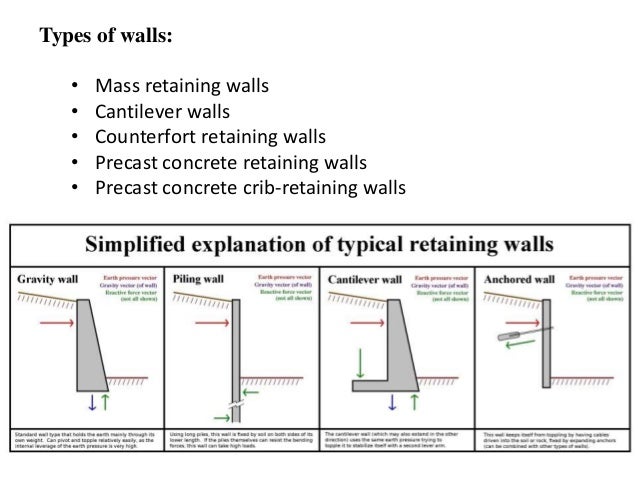More About Ace Construction Company
Table of ContentsFascination About Construction Company AustinThe Definitive Guide to Construction Company AustinHow Ace Construction Company Austin can Save You Time, Stress, and Money.Excitement About Construction Company Austin
Since these materials can not resist considerable tension, the design focuses on preventing stress in the wall. Some gravity walls do not use mortar, relying exclusively on their weight to remain in location, as when it comes to dry stone walls. These walls typically are trapezoidal in section as displayed in Fig.
2. Gravity walls need heavy foundation due to the plus size of the wall. They are affordable and appropriate for just little heights. A gravity maintaining wall supplied with a percentage of support for minimizing the mass of the concrete is called semi-gravity keeping wall, as revealed in Fig.
3. The lateral earth pressure is primarily resisted by the mass of the wall, as in the case of a gravity keeping wall. These are the strengthened concrete walls in which lateral earth pressure is resisted by structural action of its members. The base of the wall is extended into the backfill on the heel side and is referred to as heel piece, as displayed in Fig.

An Unbiased View of Construction Company Austin
The heel piece and the toe slab undergo resultant upward soil pressure from the bottom and bend upward. Support is therefore supplied on the stress side, that is, vertically on the behind of the stem and horizontally at the bottom of the heel slab and the toe piece.
Cantilever keeping walls are appropriate for retaining the backfill to moderate heights of 4-7 m. In random sample, the majority of cantilevered walls look like "L" s or inverted "T" s. construction company austin. Where foundation soils are poor, earth tieback maintaining walls are another choice. These walls are reversed not just by a large base however also by a series of horizontal bars or strips extending out from the vertical surface into the backfill.

16. 5. The check my reference stem and the heel piece function as continuous slabs covering horizontally along the length of the wall in between the counterforts. The use of counterforts reduces the bending minute due to earth pressure and hence the size and support of the stem and the heel slab. Counterforts undergo stress due to the action of lateral earth pressure of the backfill on the stem.
The Of Ace Construction Company Austin
Figure 16. 6 reveals a strengthened keeping wall. The structural action of the stem is the same as in a counterfort maintaining wall. Nevertheless, the heel piece serves as a cantilever slab as in a cantilever maintaining wall. The toe piece acts as a continuous piece spanning along the length of the wall between the buttresses.
ADS: Sheet stacks are versatile retaining structures utilized to offer a temporary construction area for construction of structures. Sheet stacks are made of lumber, steel, or often reinforced concrete. Lumber sheet stacks were utilized in the past however their reuse is restricted for short-term structures approximately shallow depth (construction company austin). For all crucial structures and for depth > 3 m, steel sheet stacks are more frequently used.
Strengthened cement concrete (RCC) sheet stacks might be sometimes utilized in fine sand or soft clays. RCC piles might get damaged or broken under driving stresses in stiff soils. Sheet piles are installed by very first driving the steel or timber sheets into the soil. The soil on the front side is then dredged (removed) out.
Specific steel sheets are joined by ball-and-socket joints to get the required length of sheet stacks. A traditional RCC retaining wall obtains its assistance primarily from the click here for info weight of the wall in addition to from the weight of the soil retained above the heel piece. The depth of foundation is typically small, and passive resistance of the soil is generally disregarded in the style.
Construction Company Austin Fundamentals Explained
For this reason, the depth of foundation (embedment) is big compared with that in a maintaining wall. The thickness of sheet stacks is extremely small compared with the depth and length of a wall. Thus, the weight of a sheet stack is extremely little and is usually disregarded in the style. ADVERTISEMENTS: The soil on the back of the sheet pile is generally removed and backfilled with a cohesionless soil.
However, the soil below the dredge level might be either a cohesionless soil or a cohesive soil, depending upon the soil profile at the website of construction. Sheet piles having water on the front side utilized in dock and harbor structures to help with berthing of vessels (ships) are understood as bulk heads.
Standard areas of steel sheet piles as suggested by United States Steel (1984) are revealed in Table 16. 3. i. Cantilever sheet pile. ii. Anchored sheet stack. The cantilever sheet stack obtains its support from the embedment into the underlying soil below the dredge level, as shown in Fig. 16. 11.
